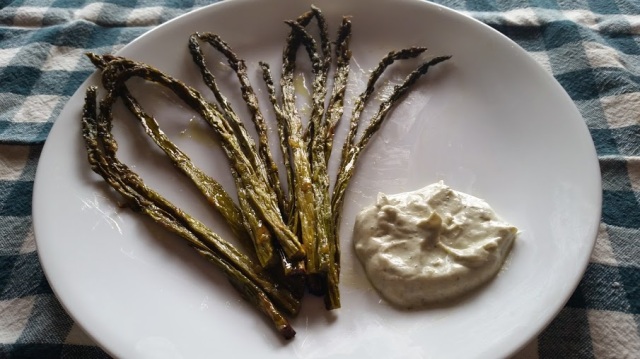Easter is over but for the hardboiled eggs, jelly beans, and leftovers. Glorious, hammy leftovers. But this post isn’t about all the ways to use your leftover Easter eggs, candy, or even that ham. This is about my happy, homely little accident. That’s right, homely, not homey. ‘Cause this asparagus sure ain’t purty.
The kids were with their mom for Easter this year, so it was just Mr. Pants, the doggies, and yours truly. We decided to make a huge bone-in ham as usual because, well, because “glorious, hammy leftovers”, remember? There were a couple other favorite holiday dishes beloved of Mr. Pants, and I decided I would treat myself to roasted asparagus. I say “myself” because Mr. Pants does not eat asparagus. More for me! I turned the oven off when the asparagus was just about done, finished the rest of the dishes, carved the ham, aaand promptly forgot I had asparagus in the oven until we started cleaning up after dinner. Into a container the asparagus and juices went, like the rest of the leftovers, to be eaten later.
I got home from work this afternoon and found myself hungry for a snack. Aha! I have leftover asparagus in the fridge that I’ll just nuke a little bit and warm up! A light snack that I could nibble with a favorite veggie dip. Now, here’s where the happy accident part comes in. I nabbed a cold asparagus spear before placing the container in the microwave and took a bite. I tasted asparagus. I tasted the sea salt, olive oil, and Ghee the asparagus had been roasted in. I tasted…. Ambrosia. Because they had been left in the hot oven, they were roasted longer than usual. They were shriveled, but had achieved a caramelization I hadn’t had with asparagus before. Then during their stay in the refrigerator they had continued to soak up all the flavors of the fruity olive oil and nutty Ghee; even the brininess of the sea salt seemed intensified. While the stems were soft, the tips were still nice and crunchy from the roasting. I can’t decide which end I liked best.
I had made myself a lemony, garlicky, dill-icious (see what I did there?) dip that’s perfect with the brightness of asparagus, and I’ve included the recipe. I even served some with my snack. I just didn’t find myself using it, preferring to eat the cold spears on their own! If you want to use the dip, I suggest you make it a couple days ahead of time to give the garlic time to mellow and the flavors time to meld.
A quick word about Ghee: this is a clarified butter used in Indian cooking. It’s made a little differently than the clarified butter you dip your crab legs in. Instead of removing the milk solids, the solids are left to caramelize at the bottom of the pan, leaving the Ghee with a nutty flavor. It also has a higher smoke point than regular butter, so it’s perfect for high heat roasting. Find it in the organic section of your grocery store, at your local health food store, or online (I know Amazon carries it). It’s a little spendy (I spent about $8 for a 7.5 oz jar at a local store), but it doesn’t take much to impart big flavor, so a small jar goes a long way. It’s shelf stable even after opening (as long as you store it in a “cool, dark location”), so it lasts a long time, too. Okay, that was not a quick word about Ghee, but don’t you feel better informed now? Well, that’s what I’m going to let myself believe. You don’t have to use it here, but I honestly think it added to the overall scrumptiousness of the asparagus!
This asparagus is delicious right from the oven, but I encourage you to either make it the day before and serve cold or at room temperature, or make extra so you can give yourself a delicious snack the next day!
Roasted Asparagus with Scrump-Dilly-icious Dip
for the dip:
1/2 cup Greek yogurt or light sour cream
1/2 cup mayonnaise
1 garlic clove, minced
1 Tablespoon lemon juice
zest of 1/2 to whole lemon
1 Tablespoon fresh dill
Mix all ingredients together and refrigerate until ready to use. I like to prepare this a day or two ahead of time, then I can adjust amounts of garlic, lemon zest, and dill to taste.
for the asparagus:
1-2 bundles of asparagus, woody ends removed (bend an asparagus stalk near the end to find the natural breaking point; cut all the stalks at the same spot and you should be good)
1 Tablespoon olive oil and 1 Tablespoon Ghee, melted and mixed together; or 2 Tablespoons olive oil
healthy pinch (use 2-3 fingers plus your thumb to pinch) sea salt or Kosher salt
Preheat the oven to 425 degrees.
Toss the asparagus in the oil and Ghee mixture (or just oil if omitting the Ghee), and sprinkle with the salt. Spread the asparagus out on a lined sheet pan and roast for about 30 minutes or until the asparagus achieves caramelization (this will depend on the thickness of the stalks).





